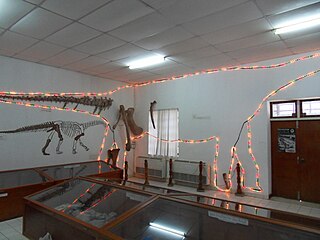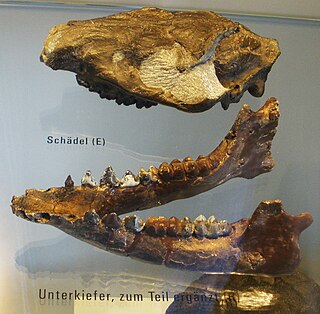
Orrorin tugenensis is a postulated early species of Homininae, estimated at 6.1 to 5.7 million years ago and discovered in 2000. It is not known how Orrorin are related to modern humans. Its discovery was used to argue against the hypothesis that australopithecines are human ancestors, although this remains the most prevalent hypothesis of human evolution as of 2012.

Pseudaelurus is a prehistoric cat that lived in Europe, Asia and North America in the Miocene between approximately twenty and eight million years ago. It is considered to be a paraphyletic grade ancestral to living felines and pantherines as well as the extinct machairodonts (saber-tooths), and is a successor to Proailurus. It originated from Eurasia and was the first cat to reach North America, when it entered the continent at about 18.5 Ma ending a 'cat-gap' of 7 million years. The slender proportions of the animal, together with its short, viverrid-like legs, suggest that it may have been an agile climber of trees.

Viverridae is a family of small to medium-sized, feliform mammals. The viverrids comprise 33 species placed in 14 genera. This family was named and first described by John Edward Gray in 1821. Viverrids occur all over Africa, southern Europe, and South and Southeast Asia, across the Wallace Line.

Dicerorhinus is a genus of the family Rhinocerotidae, consisting of a single extant species, the two-horned Sumatran rhinoceros, and several extinct species. The genus likely originated in the Mid to Late Pliocene of Northern Indochina and South China. Many species previously placed in this genus probably belong elsewhere.

Rhinoceros is a genus comprising one-horned rhinoceroses. This scientific name was proposed by Swedish taxonomist Carl Linnaeus in 1758. The genus contains two species, the Indian rhinoceros and the Javan rhinoceros. Although both members are threatened, the Javan rhinoceros is one of the most endangered large mammals in the world with only 60 individuals surviving in Java (Indonesia). The word 'rhinoceros' is of Greek origin meaning "nose-horn". Some rhinocerotids are defined as any of several large rhinocerotoids of the rhino family Rhinocerotidae.

Dryopithecus is a genus of extinct great apes from the middle–late Miocene boundary of Europe 12.5 to 11.1 million years ago (mya). Since its discovery in 1856, the genus has been subject to taxonomic turmoil, with numerous new species being described from single remains based on minute differences amongst each other, and the fragmentary nature of the holotype specimen makes differentiating remains difficult. There is currently only one uncontested species, the type species D. fontani, though there may be more. The genus is placed into the tribe Dryopithecini, which is either an offshoot of orangutans, African apes, or is its own separate branch.

Ouranopithecus is a genus of extinct Eurasian great ape represented by two species, Ouranopithecus macedoniensis, a late Miocene hominoid from Greece and Ouranopithecus turkae, also from the late Miocene of Turkey.

Hyaenodon ("hyena-tooth") is an extinct genus of carnivorous placental mammals from extinct tribe Hyaenodontini within extinct subfamily Hyaenodontinae, that lived in Eurasia and North America from the middle Eocene, throughout the Oligocene, to the early Miocene.

Tangvayosaurus is a genus of sauropod dinosaur from the Aptian-Albian age Lower Cretaceous Gres superieurs Formation of Savannakhet Province, Laos. It was a basal somphospondylan, about 15 m long, and is known from the remains of two or three individuals.

Martin Pickford is a lecturer in the Chair of Paleoanthropology and Prehistory at the Collège de France and honorary affiliate at the Département Histoire de la Terre in the Muséum national d'Histoire. In 2001, Martin Pickford together with Brigitte Senut and their team discovered Orrorin tugenensis, a hominid primate species dated between 5.8 and 6.2 million years ago and a potential ancestor of the genus Australopithecus.
Paleontology or palaeontology is the study of prehistoric life forms on Earth through the examination of plant and animal fossils. This includes the study of body fossils, tracks (ichnites), burrows, cast-off parts, fossilised feces (coprolites), palynomorphs and chemical residues. Because humans have encountered fossils for millennia, paleontology has a long history both before and after becoming formalized as a science. This article records significant discoveries and events related to paleontology that occurred or were published in the year 1992.
Paleontology or palaeontology is the study of prehistoric life forms on Earth through the examination of plant and animal fossils. This includes the study of body fossils, tracks (ichnites), burrows, cast-off parts, fossilised feces (coprolites), palynomorphs and chemical residues. Because humans have encountered fossils for millennia, paleontology has a long history both before and after becoming formalized as a science. This article records significant discoveries and events related to paleontology that occurred or were published in the year 1999.

Stephanorhinus is an extinct genus of two-horned rhinoceros native to Eurasia and North Africa that lived during the Late Pliocene to Late Pleistocene. Species of Stephanorhinus were the predominant and often only species of rhinoceros in much of temperate Eurasia, especially Europe, for most of the Pleistocene. The last two species of Stephanorhinus – Merck's rhinoceros and the narrow-nosed rhinoceros – went extinct during the last glacial period.

Brachypotherium is an extinct genus of rhinocerotid that lived in Eurasia and Africa during the Miocene. A first upper decidual molar referrable to Brachypotherium brachypus was found during gold mining in New Caledonia during the 19th century, being misidentified as a species of marsupial known as Zygomaturus. However, rhinoceros were never native to New Caledonia, and the tooth was probably used as jewelry by a French convict deported there.
Styriofelis is an extinct genus of Felidae known from the Miocene of Europe.
Notocetus is an extinct genus of river dolphin belonging to Squalodelphinidae. Known specimens have been found in Early Miocene marine deposits from Argentina, Italy and Peru.
Isohyaenodon is an extinct polyphyletic genus of hyainailourid hyaenodont mammal from the subfamily Hyainailourinae). Remains are known from early to middle Miocene deposits in Kenya, East Africa.

The jacanas are a group of tropical waders in the family Jacanidae. They are found in the tropical regions around the world. They are noted for their elongated toes and toenails that allow them to spread out their weight while foraging on floating or semi-emergent aquatic vegetation. They are also among the somewhat rare groups of birds in which females are larger, and several species maintain harems of males in the breeding season with males solely responsible for incubating eggs and taking care of the chicks.

Microbunodon was a genus of extinct artiodactyl mammals in the family Anthracotheriidae. It lived between the upper Eocene and the lower Pliocene. Its fossil remains have been found in Europe and Asia.

Dihoplus is an extinct genus of rhinoceros that lived in Eurasia from the Late Miocene to Pliocene.
















